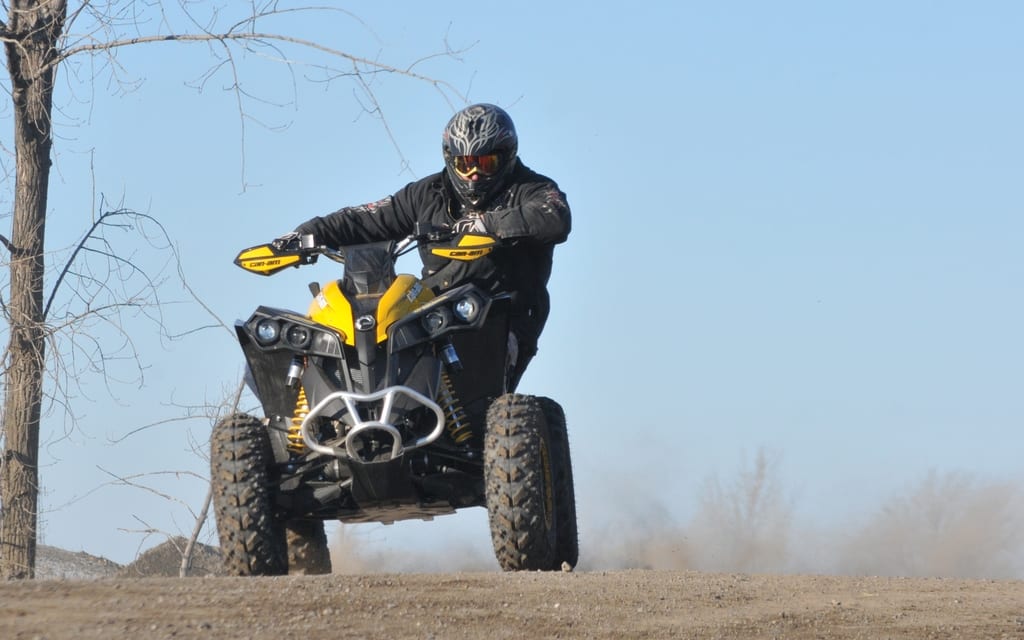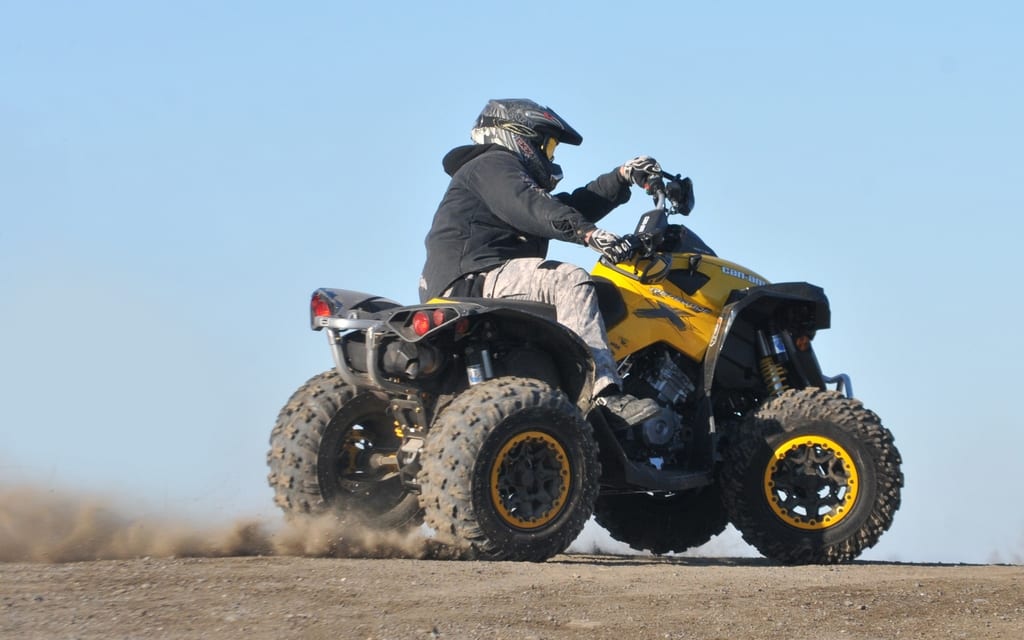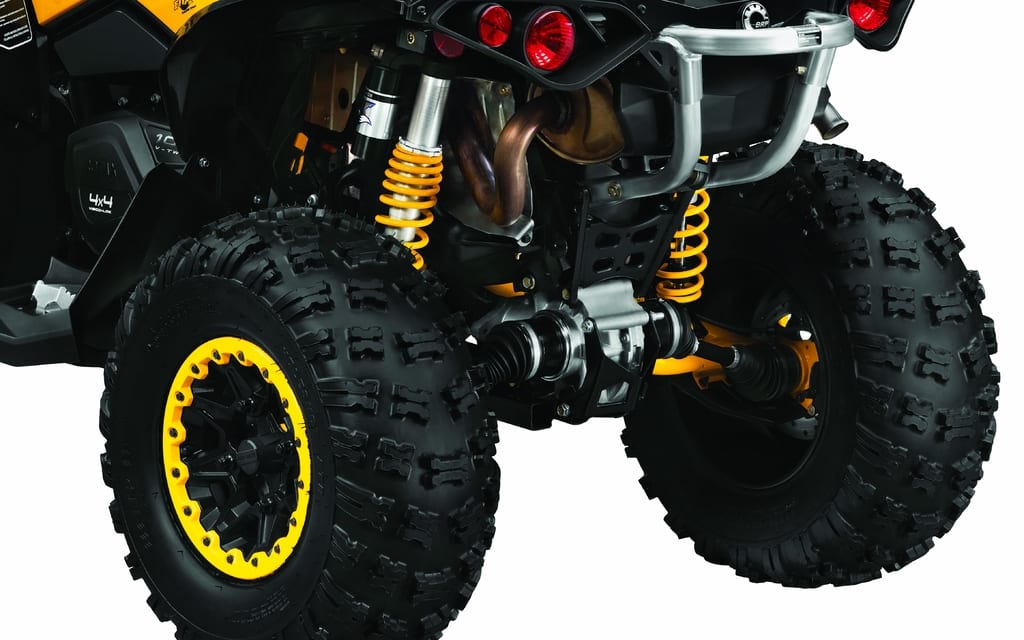The Can-Am GNCC racing program has been crucial on many fronts; it is the worktable upon which all interested in ATV sport riding can sit at. All the while, it is also used as a true to life test bed for Can-Am’s ATV engineers, who have responded to the high-performance needs of the 4×4 part of the sport with a much tougher second generation SST frame, and the meanest stock engine the ATV world has ever seen. The 800R version, still available of course, might very well remain a better fit for most extreme machine lovers; it’s a little more affordable and may offer more power than you will ever need to use. Still, even if this new 2012 Can-Am Renegade 1000 X-xc seems out of your league, discovering what makes it tick should be interesting to all ATV fans. This is, the most powerful and innovative ATV in the world!
Any ATV user, even one with little experience, can find pleasure in owning and using this quad safely. This might sound odd, even more so coming from me, who is always going on about safety and trying to encourage readers to spread the word about how important it is to carefully match a rider with the appropriate machine. Can-Am engineers have truly found the best way to make many of their high-powered products, accessible and safe to use by all. The cool trick is that you can overcome this feeling of intimidation, by taming your beast in an electronic fashion. The greatest thing for the engineers is that most of the job was already done since this vehicle, like many other Can-Am models, has a Digitally Encoded Security System. A coded microchip in the key matches a code embedded in the engine control module, which means only the owner of that code can bring the beast to life. They only needed to embed additional commands inside of two different keys, to dictate vehicle behavior through the ECM. How wonderful! Thanks to this quad’s computerized nature, you can get acquainted with it using the grey key. You get a grey one called the Normal key and a black one, the Performance key. The normal key can be used if the rider prefers less aggressive acceleration and smoother throttle response for certain conditions, such as rock crawling or riding in tight and rough trails, or simply to feel more at ease with the vehicle’s tamed character in general. The Renegade’s top speed will also be limited to 70 km/h (43 mph) with this key, which sounds like a huge advantage for when someone asks to try out your trail beast, like your 16-year-old brother, begging you to lend it to him, so he can show-off in front of his friends. No need to mention the key thing, right? Of course, I tried to have my fun with Fox and Fitto, my two talented fellow Renegade 1000 X-xc test riders, but failed as it took Fitto just a few seconds to turn around and ask for the black key with a smile. If your young bro is simply too quad savvy, and knows about the grey’s significance like Fitto did, you can always paint it black.
FRESH AIR READY
Filtering and processing air is a crucial part of a machine with such tough endurance racing inspired features. So like it is the case with the Outlander, a new air box was designed and placed at a higher and more centralized location. It features a dual-room concept that improves the air filtration process by capturing dirty air in one portion of the box, and clean air in another section, before sending it to the engine. The air intake is also higher in the frame to improve the machine’s capabilities in the mud and water. Also new is the battery and electrical components relocation underneath the seat for easier maintenance.
You have to look at it from the rear, to tell it apart from the 800. The most noticeable change, which gives it away as a much larger displacement machine, is the huge car-like shaped muffler. The new tail lights, with brake lights, are an even more visible change and truly tie-in with the rest of the plastics perfectly, to give the whole ride a more high-tech and finished look. Then, with a peer a little deeper, a new TTI set-up is also obvious, mainly because the rear suspension’s vertically swaying arms are now made of big bright yellow tubing. This X xc version, offers a race inspired cross-country package, on top of all the standard Renegade 1000 features, and the most significant ones are the different, much higher end suspension units. The factory installed Fox shocks offer a lot more flexibility and fine tuning than any other 4×4 ATV. Like on any race prepped 450, the suspension can be set precisely in accordance with rider dimensions, preferences, and with the needs of the moment. There are many different adjustment possibilities and it is important to know that these can affect the handling of the machine, which the rider will need to get re-acquainted with, in a prudent and gradual fashion. It is also important to make only small changes at a time and test how the quad reacts to them. The spring pre-load can easily and finely be adjusted with the threaded rings. The low speed compression damping is adjusted with the simple turn of a flat screwdriver and the high speed with a 17mm wrench at the top of the shocks, while the rebound sits at the bottom, also easily changed with a flat screwdriver. Make sure you keep tires always at the same pressure throughout your changes, so not to taint your results. Choose a preferred tire pressure in between 5 and 7 lb. of recommended pressure, and stick to the same one all the time!
IN CHECK
Speaking of maintenance, another great advantage to having a machine so equipped with electronic fuel injection, a generous amount of sensors and a multi-function gauge equipped with a digital information centre that will create an open communication between the rider and his machine. You won’t be able to forget a scheduled maintenance overall, the Renegade will tell you when it needs one and also warn you, if any of the sensors detects an anomaly by displaying a clear and big scrolling message on the gauge like a high temperature warning, low oil, or even a park brake message, when the ride moves forward for more than 15 seconds with the park brake still engaged, to name only a few. Of course, you will need to take care of a lot of other things, every 750 km or 25 hours of use, whichever comes first. More importantly, you will need to replace your engine’s air filter, inspecting and cleaning the CVT transmission’s air filter, if you have been riding in dusty environments. Inspection of the brake fluid level, brake pads, wheel lug nuts, drive shaft boots and protectors are also important at this frequency. On the second scheduled maintenance, at 50 hours or 1500 km, you will need to do all of the above things and add the inspection, adjustment and lubrication of the throttle cable. If you’ve been riding in fairly clean, normal riding conditions, your first change of the engine’s air filter can now be done too, along with many other important things. The front differential and rear final drive oil level needs to be checked, all shaft joints checked for their condition, and the rear propeller shaft joint musts be greased. At this point, you will also need to inspect tie rod ends, shock absorbers for any leaks, and also check and lubricate the front suspension A-arms and rear sway bar link bushings. The first engine oil and filter change and replacing the oil in the rear final drive will be the main things to do after a year or at 3000 km, or maybe 100 hours in operation, but there will be many key elements to check that time around and I strongly suggest you let the pros at your dealership take care of. Adjusting the valve clearance, cleaning the spark arrester, checking engine coolant strength, cleaning the throttle body and fuel pump pre-filter, replacing the fuel vent breather filter and carrying out a fuel pump pressure test, are all things that require a certain amount of skill and Tools, owned by a certified mechanic. At that point the ride also needs a full check-up of the drive system. The drive and driven pulleys and the one-way bearing will need proper cleaning and lubrication, and the drive belt musts be inspected. Finally, the gearbox oil level and condition must be checked and the steering system and wheel bearings must be inspected for abnormal play.
MORE MEANS BETTER
Picking up this copy of, the fastest and most aggressively powerful quad ever built, was already providing us with thrills! There was no denying that it was one of coolest rides to grace the box of our truck and made it even look better. The new Renegade 1000 X-xc later revealed how it provides a serious punch in power, which a skilled rider can truly put to good use. We can finally say that we truly don’t need or want more power. The 46 inches in width can feel a bit on the limit in some situations, but I for one, have no problem with having to give a generous weight shift, when needed, since the foot pegs and seat are so well-designed. The fact that the rear wheel braking is so much more responsive upon release is a huge improvement. The pedal is still high for my taste, but now precise enough, and the engine braking doesn’t steal away any of it. This gives control of how the rear wheels act, entirely back to the rider. The gear selector also has a much-improved feel to it, the park brake much easier to use, and new Tri-mode DPS, clearly much more adaptable to different conditions, or rider types and preferences, than any other power-steering system made today. The minimum assist mode was everybody’s preferred setting. Still, the medium and maximum modes can surely become highly practical when the sun starts getting low and you have been riding hard all day long, or when a tough rock climb needs to be conquered with confidence and efficiency. The DPS will also significantly, smooth out impacts felt in the arms and wrists when hitting rocks.
WHAT MORE COULD ONE WANT?
Honestly, we are jumping with joy since we first rolled the new 2012 Can-Am Renegade 1000 X-xc into our truck, and trust me; we have only begun to discover the possibilities at the controls of this beautiful trail monster, and are totally satisfied with every little attention to detail on this particularly well-equipped and hot-looking version. The small bolts on the fenders instead of those annoying plastic fasteners. The repositioning of the front ball-joints tucked deep inside the wheels, and permitting an upgrade in front tire width, without the need for any modifications. Simple choices like these can make a world of difference to the owner in the long run.
We have been lucky enough to gain access to some really cool spots to test ride quads lately, and you can be assured that we will profit from as many of them as possible, with this mighty ground-trembling machine. Oddly enough, Motocross or Enduro racing tracks, like the ones found at X-Town in Mirabel, Quebec, or the amazing Mecaglisse motorsport complex, or a new track in Franklin, under one hour drive from downtown Montreal. Those have become appropriate places to ride such sporty big and powerful 4×4 ATVs. We might not fly as High, and clear all the ramp to ramp jumps, as we would, straddling an ultra-light 450, but you would be surprised to see how efficient and fun it can be on a rainy day, in any of those places.
This low-rumbling loose dirt hungry Rotax engine is really just asking for it; with such a sweet sound at idle. A generous press of the throttle is fun to experience, but you will be quick to want to release it, as the machine will gain speed like nothing you have ever experienced! Electronic fuel injection makes all that 88 hp power nice and crisp, no matter the conditions you ride in. It might also somewhat mean that the owner is much less in control or able to “Jimmy” something, if, however unlikely, the engine doesn’t want to start or seems not to run well. Before we could always tinker with the carburetor, but now the computer and all the sensors connected to it make all the decisions, which can be a little more mysterious at times, but is much better in general. When problems do arise, most of the time these will be self-diagnosed by the unit itself, which means there is less chance of one problem going unnoticed and causing other ones. One good thing to know, with any more technologically advanced quad, is that a simple turning everything off, waiting a few moments, and then turning the key on again, will sometimes solve weird and randomly occurring problems. If an EFI engine doesn’t feel or sound like it is running well, first thing you could do, is turn the key to the off position and check the battery connections, to make sure they are tight. Loose cables will almost always cause all kinds of weird symptoms. A quick check of your spark plugs can say a lot, as always. Engine misfire will almost always be caused by either a faulty plug or water in your fuel. If for some reason the engine was flooded and the spark plugs were wet with fuel when removed, the EFI system does have a Drowned mode, a special mode that will cut fuel supply and ignition while cranking the engine. Just turn the key on, fully press the throttle and press the start button to crank for about 20 seconds. Then, simply release the throttle and press start button again without touching the throttle at all, and it should do the trick!
It surely has a lot to offer, performance wise; the highly adjustable suspension, the solid bead lock wheels, the sturdy G2 SST frame and, of course, the superbly powerful engine, with the black key, of course, all come together into a ride that anyone can be proud to own. In our case, we consider ourselves very lucky to have the opportunity to show you what this machine is capable of, and just love to play with this awesome 4×4 sport quad. Looking for some spectacular action footage of this beast in action? Well, be sure to click the videos tab at www.atvtrailrider.ca once in a while, as we always try to pick the most awesome and fun to watch in action machines, and this new monstrously aggressive Renegade is certainly among those.
Be wise, stay safe, and enjoy!
For more information on the above mentioned models, please visit the Can-Am Off-Road Website
More from Can-Am on ATV Trail Rider :
Can-Am ATV Models – Can-Am UTV Models – Can-Am ATV Reviews – Can-Am UTV Reviews








